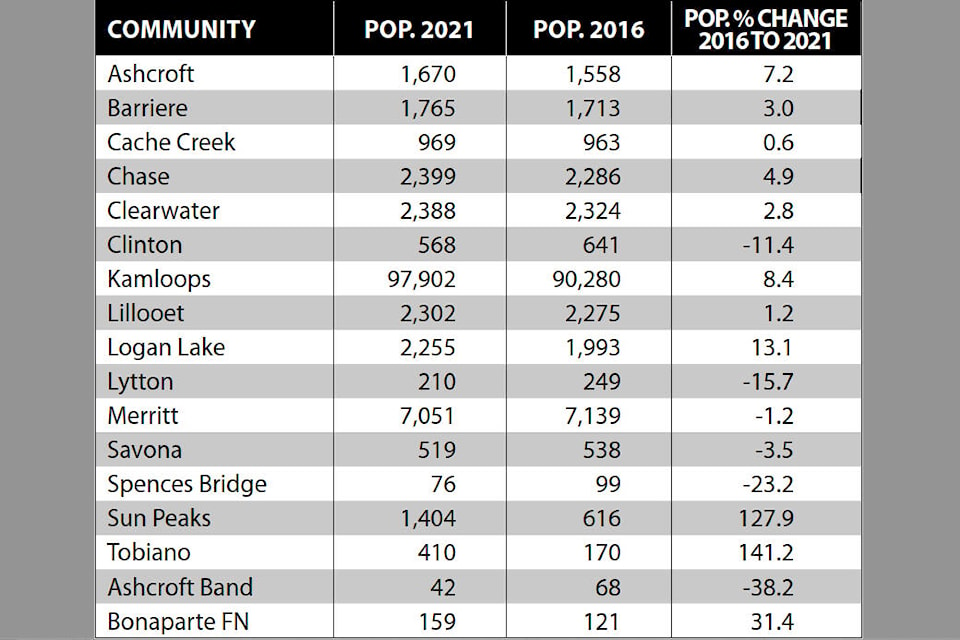The first set of numbers from the 2021 Census of Canada were released on Feb. 9, and show that the population of B.C. grew by 7.6 per cent since the last census in 2016; the second-highest growth rate among Canada’s 10 provinces.
The population of B.C. now stands at 5.071 million. Nationally, Canada’s population grew by 5.2 per cent, and is now 36.99 million.
Regionally, the City of Kamloops was the third fastest-growing census metropolitan area in Canada, with a city population of 97,902; an increase of 8.4 per cent since the last census was carried out. The Resort Municipality of Sun Peaks saw a staggering 127.9 per cent increase (from 616 to 1,404); the two other municipalities in the TNRD that saw growth near (or above) the provincial average were Logan Lake at 13.1 per cent (1,993 to 2,255) and Ashcroft at 7.2 per cent (1,558 to 1,670).
Cache Creek increased by 0.6 per cent (963 to 969), while Clinton saw a decrease of 11.4 per cent (641 to 568). Among unincorporated communities in the TNRD, Spences Bridge fell by 23.2 per cent (99 to 76) and Savona fell by 3.5 per cent (538 to 519), while Tobiano grew by a whopping 141.2 per cent (170 to 410).
The census was conducted in May 2021, before the fire on June 30 that destroyed 90 per cent of the Village of Lytton. According to the census, the population of Lytton prior to the fire had declined by 15.7 per cent (249 to 210).
The 10 electoral areas of the TNRD increased by a total of 7.1 per cent, from 15,963 to 17,095. Seven of the 10 areas increased in population, while three decreased. Area “I” had the largest decrease at 17.7 per cent (1,262 to 1,038).
Dr. Nathanael Lauster — an Associate Professor in the Dept. of Sociology at the University of British Columbia —says that the 2021 census is a very odd one, with some interesting takeaways that have a specific bearing on more rural parts of B.C.
“Most of the time, ‘when’ a census occurs doesn’t matter,” he explains. “Time is continuous, and we expect to see trends continue. But this was a very strange census year, and Lytton is an example. The census was in May 2021 [prior to the fire in June], which encapsulates how much timing really matters.
“And we’ve seen a real turning for many people with options like work from home arrangements. They can move out of bigger cities to more desirable places in rural areas, which is a pattern that shows up in some places we’re getting information for the census about.”
Lauster says that the much bigger stories that have happened since the census was conducted may have made people think about the long-term sustainability of living where they do. “I don’t think this is fully captured by this census, so it will be interesting to see how this plays out.
“If work from home conditions persist — and a lot of people aren’t sure if they will — it could lead to the revitalization of places like Ashcroft, which has cheaper housing and is a beautiful place to be. Younger people might decide to be there, and these changes won’t show up in the May 2021 census.”
Lauster says that while May 2021 might have been the high point in terms of people leaving the system, we don’t know. “Students had left Vancouver and weren’t there for the 2021 census, but we know they’re back now. We anticipate a flood of service workers back into cities, and we know those will impact urban populations.”
Census data is a key tool used by governments of all levels when it comes to planning for services, infrastructure, health care, and more. Lauster feels that the 2021 census won’t indicate these numbers accurately, and might throw off some trends.
“The census is good at benchmarking numbers for small towns, but this particular benchmark for 2021 will be a very weird one because it has been a weird year. The timing will impact it for many years in terms of using the data.
“Usually there’s pretty solid continuity between census years. In your area it’s COVID, but not just COVID. The census took place at the height of COVID restrictions, so that makes it a weird mark, but in your area it’s fires and floods as well. I’m not really sure, in the longer term, how much we can trust these census results in terms of broader trends.
“That’s my caution. We don’t quite know what to make of these results in terms of predicting where things are going in the future. I think it’s great and worthwhile that we have this data, but I don’t think it’s quite as revealing of long-term trends as usual.”
editorial@accjournal.ca
Like us on Facebook and follow us on Twitter
